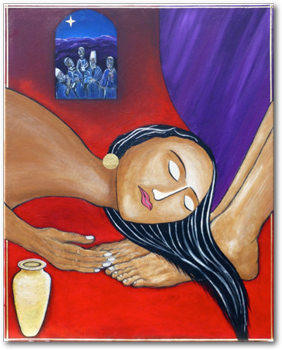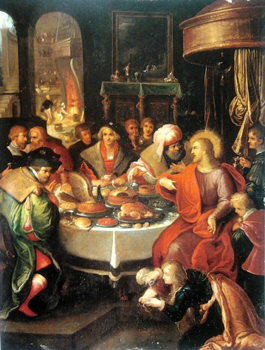For Sunday June 12, 2016
Lectionary Readings (Revised Common Lectionary, Year C)
1 Kings 21: 1-21
Psalm 5: 1-8
Galatians 2:11-21
Luke 7:36-8:3
A few years ago, a professor of divinity at Harvard announced the discovery of an ancient Coptic papyrus fragment in which Jesus purportedly mentions his wife. The announcement led to wide-spread controversy and debate, not only among academics, but within the Church. What intrigued me at the time was not the possible authenticity of the fragment (most scholars now agree it's a fake), but the vehemence with which many Christians responded to its existence.
"OF COURSE Jesus wasn't married!" was the answer I routinely got when I asked around. "He couldn't have been married! He was divine!" In other words, sure, Jesus was human... but, well, not that human. He was holy. Antiseptic. Immaculate. Heaven forbid that the Son of God might have been so embodied. So (shudder!) sensual.
In her book, An Altar in the World, Barbara Brown Taylor tells a related story about visiting a beautiful old church in Alabama. Having arrived for the service too early, she stood for a while in front of the altar, admiring a mural of Jesus emerging from his tomb. Though the painting was impressive, Taylor felt that something was off; Jesus looked too ethereal. After gazing at the mural for several seconds, she realized what was missing: Jesus had no body hair. Without thinking, she turned and shared her realization with the nearest parishioner, a polite, put-together woman with expensive clothes and a flawless manicure. "He has the arms of a six-year-old. His chest is as smooth as a peach." The parishioner's smile froze, and she stared at Taylor in abject horror. "'I can't believe you're saying this to me,' she said without moving her red lips. 'I just can't believe you're saying this to me.'"
Christians, Taylor concludes, often find themselves "in the peculiar position of being followers of the Word Made Flesh who neglect our own flesh or worse — who treat our bodies with shame and scorn." Or again: "Here we sit," says Taylor, "with our souls tucked away in this marvelous luggage, mostly insensible to the ways in which every spiritual practice begins with the body."
 |
This week's Gospel story confronts our shame head-on. No matter how hard we try to theologize or intellectualize it away, the story is naked-making. It exposes, it confronts, it directs our gaze. It's a story about the body. What the body is. What the body knows.
Feet. Tears. Perfume. Hair. All four Gospels tell it, the scandalous story of a woman who dared to love Jesus in the flesh — to love his spirit and his body with her own. Each writer frames the story differently, to suit his own thematic and theological concerns, but that hardly matters; the story at its core remains the most sensual, most shocking one in the New Testament. If it doesn't embarrass us, we're not paying attention.
In Luke's version, the story is set early in Jesus's ministry, at the home of a Pharisee named Simon. No doubt curious about the young rabbi garnering both praise and outrage in the surrounding villages, Simon invites Jesus to a dinner party. After all, why not check out the would-be prophet from Nazareth? Perhaps he'll have some fascinating things to say about religion. Maybe he'll impress the other dinner guests with a nifty miracle or two — wouldn't that be a credit to Simon, the host? If nothing else, Jesus's presence might make for some interesting chit-chat around the table.
So the invitation is extended — and accepted. The guests arrive on the appointed evening, and as they recline around an impressively laden table, Simon settles in for a few hours of good food and lively conversation.
Enter the woman with the alabaster jar. In Luke's account, the woman is unnamed and unwelcome — "a woman in the city, who was a sinner." How exactly she crashes the party, we don't know, but she manages to get in the door, approach the table, kneel quietly behind Jesus, and let down her hair. While God-knows-what transpires between the dinner guests, the woman bends over Jesus and begins to cry. She soaks Jesus's feet with her tears, caresses them dry with her hair, repeatedly kisses his soles, his toes, and his ankles, and finally breaks open her alabaster jar to anoint his salty skin with a costly perfume. As far as we know, Jesus doesn't say a word. Neither does the woman. But they communicate volumes.
Can you imagine the scene? I wonder if the conversation around the table faltered as the woman began to cry. I wonder if the temperature rose a few significant degrees, and everyone in the room reached simultaneously for the water jug. I wonder where the men looked — or didn't dare to look — as the woman wrapped Jesus's feet in her lustrous hair. I wonder if Jesus — never one to make things easy — captured Simon's gaze and held it, extending the discomfort, forcing his host to imaginatively experience every searing kiss that grazed Jesus's skin.
The temptation here is to deflect. To minimize. "Perhaps it wasn't such a big deal in the first century." "I'm sure people in that culture were more demonstrative than we are today." "Showing affection like that was probably normal back then."
No. No, it wasn't. The Gospel writer takes pains to describe just how scandalous the woman's behavior was in that time and in that place; Simon is nothing less than disgusted — not only with the woman, but with Jesus who tolerates her. Specifically, it's the woman's touch that makes Simon squirm with indignation: "If this man were a prophet, he would have known who and what kind of woman this is who is touching him — that she is a sinner."
 |
Luke sets the woman's story in the theological context of sin and forgiveness. Those who are forgiven little, love little, but those who are forgiven much, love lavishly. Simon's love is thin in this story because he doesn't recognize his need for grace. The woman, in contrast, knows full well the extent of her own sin and the wide embrace of Jesus's forgiveness, so her love for him is boundless. Needless to say, this is an important lesson, and Jesus teaches it beautifully in the parable of the creditor and the debtors he shares with Simon.
But what interests me more about this story is how much it conveys without language. What happens between Jesus and the weeping woman happens skin to skin. Unlike the Prodigal Son, who prepares an elaborate apology for his father, the woman rehearses no repentance speech, and Jesus, in turn, pronounces no lengthy absolution. The woman never says, "I need you," or "Thank you so much," or "I love you." Her contrition, her worship, her yearning, and her love are enacted wholly through her body, and Jesus receives them into his own body with gratitude, love, tenderness, and pleasure. The holy sacraments here are skin, salt, sweat, and tears. The instruments of worship are perfumed feet and ardent kisses. This is not a polite piety of the mind; this is physical extravagance. What writer Mary Gordon calls, "A Sabbath of the skin."
And Simon misses it entirely. Unable to recognize what only the body can know, Simon misses the sacred transaction happening at his own table. Notice what Jesus asks him: "Simon, do you see this woman?" It's a lacerating question. Because no, Simon doesn't see her. He doesn't see her humanity, her generosity, her capacity for deep and embodied love. Neither, in fact, does he see Jesus's humanity — the dusty feet in need of cool water, the sun-baked skin in need of fragrant ointment, the ever-giving, ever-sacrificing Son of Man in need of reciprocity, affection, and loving touch. Though he accuses Jesus of ignorance, Simon is the one who is both blind and ignorant in this story. In his eyes, Jesus needs to remains a curiosity, an idea, an abstraction — and one can't love an abstraction.
In fact, Simon needs Jesus to remain "a prophet," and the woman to remain "a sinner." His own identity — "a Pharisee" — depends on every other identity at his table remaining fixed. But this is exactly what the woman unhinges when her body enters the room. With her hair, her tears, her touch, she forces each guest back into his own skin. With her more perfect, more radical, and more offensive hospitality — a hospitality attentive to mind, soul, and body — she confronts everyone in the room with their common humanity. Do you see this woman? The weeper? The washer? The anointer? She's the one who sees and knows. She's a prophet, too.
 |
There is a cost to seeing. A cost to seeing Jesus's body. A cost to seeing my own. I write these words first and foremost to myself, because I'm also the product of a culture that treats bodies with scorn and shame. Most of the time, I see my body as something to shrink, starve, conquer, or tame. I see its flaws so much more clearly than I see its God-ordained dignity and beauty. Rarely — so rarely — do I see it as a vehicle for worship, love, hospitality, and grace. But if I can't see my own body as God's temple, if I won't embrace it as pleasing and delightful to its Creator, how will I ever see or embrace yours?
"Look at my hands and my feet; see that it is I myself," Jesus told his wary disciples after the Resurrection. "Touch me and see. A ghost does not have flesh and bones as you see that I have."
We are people of the Incarnation, called to look, to see, to break bread, share wine, and wash feet. Can we learn to see our embodied lives, our sensory lives, as fully implicated in our lives with God? Can we move past contempt, squeamishness, and fear, and offer him our whole selves?
"This is my body," Jesus says, "given for you." Touch me and see.
Image credits: (1) Blogspot.com; (2) Wikipedia.org; and (3) Wikipedia.org.





